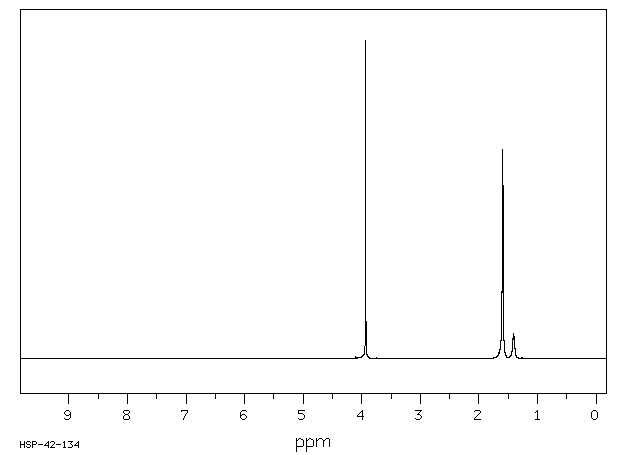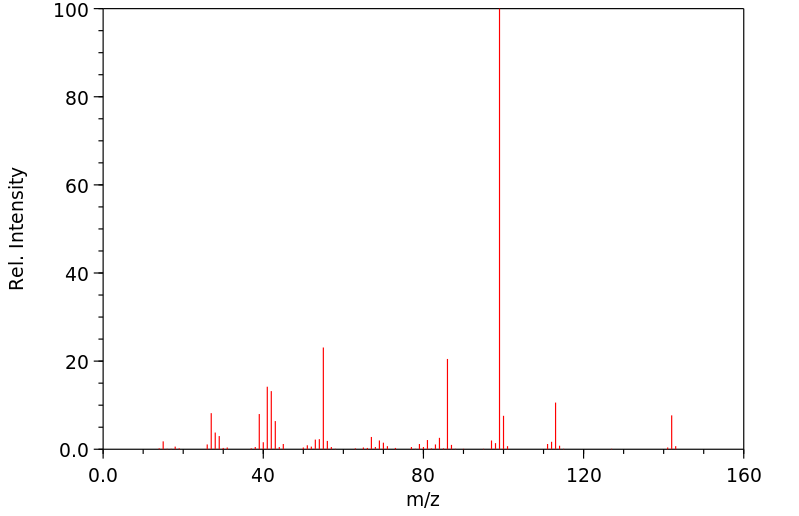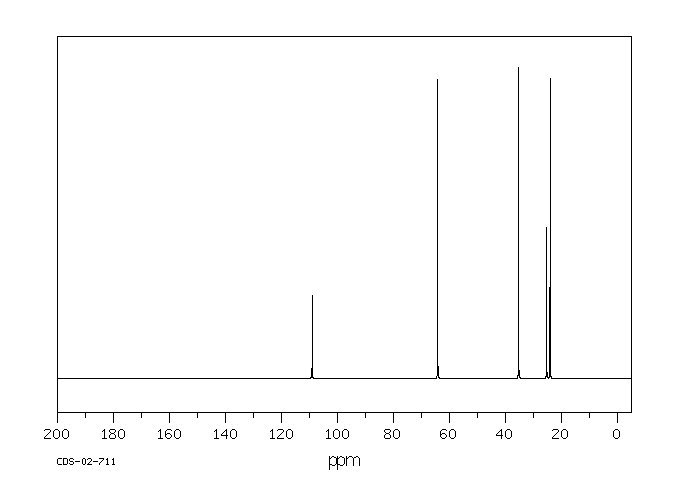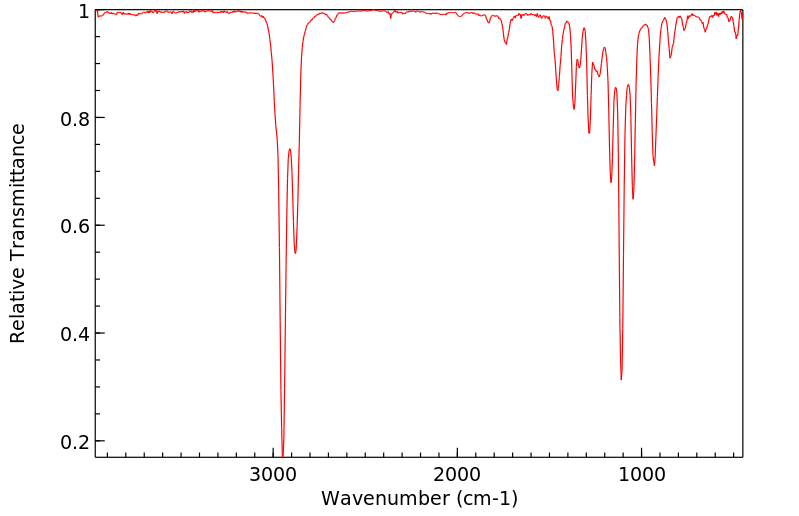1,4-二氧螺环[4,5]癸烷 | 177-10-6
中文名称
1,4-二氧螺环[4,5]癸烷
中文别名
1,4-二氧杂螺[4.5]癸烷;2,2-五亚甲基-1,3-二氧戊环
英文名称
1,3-dioxolane-2-spirocyclohexane
英文别名
1,4-dioxaspiro[4.5]decane;cyclohexanone ethylene ketal;cyclohexanone ethylene acetal;2,2-pentamethylene-1,3-dioxolane
CAS
177-10-6
化学式
C8H14O2
mdl
MFCD00005409
分子量
142.198
InChiKey
GZGPRZYZKBQPBQ-UHFFFAOYSA-N
BEILSTEIN
——
EINECS
——
-
物化性质
-
计算性质
-
ADMET
-
安全信息
-
SDS
-
制备方法与用途
-
上下游信息
-
文献信息
-
表征谱图
-
同类化合物
-
相关功能分类
-
相关结构分类
物化性质
-
熔点:176-180 °C
-
沸点:73 °C16 mm Hg(lit.)
-
密度:1.028 g/mL at 25 °C(lit.)
-
闪点:156 °F
计算性质
-
辛醇/水分配系数(LogP):1.4
-
重原子数:10
-
可旋转键数:0
-
环数:2.0
-
sp3杂化的碳原子比例:1.0
-
拓扑面积:18.5
-
氢给体数:0
-
氢受体数:2
安全信息
-
安全说明:S24/25
-
危险性防范说明:P261,P305+P351+P338
-
危险性描述:H302,H315,H319,H335
-
储存条件:存放于惰性气体中,并避免接触湿气(否则可能导致分解)。
SDS
| Name: | 2 2-Pentamethylene-1 3-Dioxolane 99% Material Safety Data Sheet |
| Synonym: | Cyclohexanone Ethylene Acetal; Cyclohexanone Ethylene Ketal; 1,4-Dioxaspiro(4.5)Decane |
| CAS: | 177-10-6 |
Synonym:Cyclohexanone Ethylene Acetal; Cyclohexanone Ethylene Ketal; 1,4-Dioxaspiro(4.5)Decane
Section 2 - COMPOSITION, INFORMATION ON INGREDIENTS
| CAS# | Chemical Name | content | EINECS# |
| 177-10-6 | 2,2-Pentamethylene-1,3-Dioxolane | 99% | 205-867-0 |
Risk Phrases: None Listed.
Section 3 - HAZARDS IDENTIFICATION
EMERGENCY OVERVIEW
The toxicological properties of this material have not been fully investigated.
Potential Health Effects
Eye:
May cause eye irritation. May cause chemical conjunctivitis and corneal damage.
Skin:
May cause irritation and dermatitis. May cause cyanosis of the extremities.
Ingestion:
May cause gastrointestinal irritation with nausea, vomiting and diarrhea. The toxicological properties of this substance have not been fully investigated.
Inhalation:
May cause respiratory tract irritation. The toxicological properties of this substance have not been fully investigated. Aspiration may lead to pulmonary edema. Inhalation at high concentrations may cause CNS depression and asphixiation.
Chronic:
Effects may be delayed.
Section 4 - FIRST AID MEASURES
Eyes: Immediately flush eyes with plenty of water for at least 15 minutes, occasionally lifting the upper and lower eyelids. Get medical aid.
Skin:
Get medical aid. Flush skin with plenty of water for at least 15 minutes while removing contaminated clothing and shoes. Wash clothing before reuse.
Ingestion:
Never give anything by mouth to an unconscious person. Get medical aid. Do NOT induce vomiting. If conscious and alert, rinse mouth and drink 2-4 cupfuls of milk or water.
Inhalation:
Remove from exposure and move to fresh air immediately. If breathing is difficult, give oxygen. Get medical aid. Do NOT use mouth-to-mouth resuscitation. If breathing has ceased apply artificial respiration using oxygen and a suitable mechanical device such as a bag and a mask.
Notes to Physician:
Section 5 - FIRE FIGHTING MEASURES
General Information:
As in any fire, wear a self-contained breathing apparatus in pressure-demand, MSHA/NIOSH (approved or equivalent), and full protective gear. During a fire, irritating and highly toxic gases may be generated by thermal decomposition or combustion. Use water spray to keep fire-exposed containers cool. Combustible liquid.
Vapors may be heavier than air. They can spread along the ground and collect in low or confined areas. Containers may explode when heated.
Runoff from fire control or dilution water may cause pollution.
Extinguishing Media:
Use water spray to cool fire-exposed containers. Use agent most appropriate to extinguish fire. Use water spray, dry chemical, carbon dioxide, or alcohol-resistant foam.
Section 6 - ACCIDENTAL RELEASE MEASURES
General Information: Use proper personal protective equipment as indicated in Section 8.
Spills/Leaks:
Absorb spill with inert material (e.g. vermiculite, sand or earth), then place in suitable container. Avoid runoff into storm sewers and ditches which lead to waterways. Clean up spills immediately, observing precautions in the Protective Equipment section. Remove all sources of ignition. Use a spark-proof tool. Provide ventilation.
Section 7 - HANDLING and STORAGE
Handling:
Wash thoroughly after handling. Remove contaminated clothing and wash before reuse. Use only in a well-ventilated area. Avoid contact with eyes, skin, and clothing. Empty containers retain product residue, (liquid and/or vapor), and can be dangerous. Keep container tightly closed. Keep away from heat, sparks and flame. Avoid ingestion and inhalation. Do not pressurize, cut, weld, braze, solder, drill, grind, or expose empty containers to heat, sparks or open flames.
Storage:
Keep away from sources of ignition. Keep container closed when not in use. Store in a tightly closed container. Store in a cool, dry, well-ventilated area away from incompatible substances.
Section 8 - EXPOSURE CONTROLS, PERSONAL PROTECTION
Engineering Controls:
Facilities storing or utilizing this material should be equipped with an eyewash facility and a safety shower. Use adequate ventilation to keep airborne concentrations low.
Exposure Limits CAS# 177-10-6: Personal Protective Equipment Eyes: Wear appropriate protective eyeglasses or chemical safety goggles as described by OSHA's eye and face protection regulations in 29 CFR 1910.133 or European Standard EN166.
Skin:
Wear appropriate protective gloves to prevent skin exposure.
Clothing:
Wear appropriate protective clothing to minimize contact with skin.
Respirators:
Follow the OSHA respirator regulations found in 29 CFR 1910.134 or European Standard EN 149. Use a NIOSH/MSHA or European Standard EN 149 approved respirator if exposure limits are exceeded or if irritation or other symptoms are experienced.
Section 9 - PHYSICAL AND CHEMICAL PROPERTIES
Physical State: Liquid
Color: clear, colorless
Odor: Not available.
pH: Not available.
Vapor Pressure: Not available.
Viscosity: Not available.
Boiling Point: 73 deg C @ 16.00mm Hg
Freezing/Melting Point: Not available.
Autoignition Temperature: Not applicable.
Flash Point: 69 deg C ( 156.20 deg F)
Explosion Limits, lower: Not available.
Explosion Limits, upper: Not available.
Decomposition Temperature:
Solubility in water:
Specific Gravity/Density: 1.0280g/cm3
Molecular Formula: C8H14O2
Molecular Weight: 142.20
Section 10 - STABILITY AND REACTIVITY
Chemical Stability:
Stable under normal temperatures and pressures.
Conditions to Avoid:
Incompatible materials, ignition sources, excess heat, strong oxidants.
Incompatibilities with Other Materials:
Oxidizing agents.
Hazardous Decomposition Products:
Carbon monoxide, irritating and toxic fumes and gases, carbon dioxide.
Hazardous Polymerization: Has not been reported
Section 11 - TOXICOLOGICAL INFORMATION
RTECS#:
CAS# 177-10-6: JH2800000 LD50/LC50:
Not available.
Carcinogenicity:
2,2-Pentamethylene-1,3-Dioxolane - Not listed by ACGIH, IARC, or NTP.
Other:
See actual entry in RTECS for complete information.
Section 12 - ECOLOGICAL INFORMATION
Section 13 - DISPOSAL CONSIDERATIONS
Dispose of in a manner consistent with federal, state, and local regulations.
Section 14 - TRANSPORT INFORMATION
IATA
Not regulated as a hazardous material.
IMO
Not regulated as a hazardous material.
RID/ADR
Not regulated as a hazardous material.
Section 15 - REGULATORY INFORMATION
European/International Regulations
European Labeling in Accordance with EC Directives
Hazard Symbols: Not available.
Risk Phrases:
Safety Phrases:
S 24/25 Avoid contact with skin and eyes.
WGK (Water Danger/Protection)
CAS# 177-10-6: No information available.
Canada
None of the chemicals in this product are listed on the DSL/NDSL list.
CAS# 177-10-6 is not listed on Canada's Ingredient Disclosure List.
US FEDERAL
TSCA
CAS# 177-10-6 is not listed on the TSCA inventory.
It is for research and development use only.
SECTION 16 - ADDITIONAL INFORMATION
N/A
上下游信息
-
上游原料
中文名称 英文名称 CAS号 化学式 分子量 1,4-环己二酮单乙二醇缩酮 cyclohexanedione monoethylene ketal 4746-97-8 C8H12O3 156.181 环己酮二甲缩酮 1,1-Dimethoxycyclohexane 933-40-4 C8H16O2 144.214 (R)-1,4-二氧杂螺[4,5]癸烷-2-甲醛 (R)-2,3-cyclohexylideneglyceraldehyde 78008-36-3 C9H14O3 170.208 6-氯-1,4-二氧杂螺[4.5]癸烷 (R,S)-6-chloro-1,4-dioxaspiro<4.5>decane 6954-16-1 C8H13ClO2 176.643 -
下游产品
中文名称 英文名称 CAS号 化学式 分子量 1,4-二氧杂螺[4.6]十一烷 1,4-dioxaspiro[4.6]undecane 184-26-9 C9H16O2 156.225 —— 2-<(1-methoxycyclohexyl)oxy>ethanol —— C9H18O3 174.24 —— 7-methyl-1,4-dioxa-spiro[4.5]decane 935-46-6 C9H16O2 156.225 环己酮二甲缩酮 1,1-Dimethoxycyclohexane 933-40-4 C8H16O2 144.214 3,3-二甲基1,5-二氧杂螺[5.5]十一烷 3,3-dimethyl-1,5-dioxa-spiro[5.5]undecane 707-29-9 C11H20O2 184.279 —— 8-(2,2,2-trifluoroethylidene)-1,4-dioxaspiro[4.5]decane 1429029-58-2 C10H13F3O2 222.207 4,4-二甲基-1,5-二氧杂螺[5.5]十一烷 2,2-dimethyl-1,5-dioxaspiro<5.5>undecane 82815-98-3 C11H20O2 184.279 —— 6-bromo-1,4-dioxaspiro[4.5]decane 97764-94-8 C8H13BrO2 221.094 2-(环己氧基)乙醇 2-Cyclohexyloxyethanol 1817-88-5 C8H16O2 144.214 2,4,4-三甲基-1,5-二氧杂螺[5.5]十一烷 2,2,4-trimethyl-1,5-dioxaspiro<5.5>undecane 6413-57-6 C12H22O2 198.305 —— 3,3-bis(bromomethyl)-1,5-dioxaspiro<5.5>undecane 121705-21-3 C11H18Br2O2 342.071 —— 2,6-Dibromcyclohexanonaethylenketal 13250-26-5 C8H12Br2O2 299.99 - 1
- 2
反应信息
-
作为反应物:描述:1,4-二氧螺环[4,5]癸烷 在 polyaniline-sulfate salt 、 水 作用下, 反应 0.75h, 以95%的产率得到环己酮参考文献:名称:Polyaniline-Supported Sulfuric Acid Salt as a Powerful Catalyst for the Protection and Deprotection of Carbonyl Compounds摘要:结构不同的羰基化合物在干燥甲苯中以聚苯胺硫酸盐为催化剂,优异地转化为相应的环状缩醛。随后,演示了在水相介质中的有用脱缩醛反应。还证明了羰基化合物的化学选择性保护。聚苯胺硫酸盐的优势在于制备和操作简便、稳定性、可重复使用性和活性。DOI:10.1055/s-2003-41412
-
作为产物:描述:参考文献:名称:由羟烷基烯醇醚形成立体缩酮,这是一种立体电子控制的内触发环化过程†摘要:在1当量的存在下,酸催化的环状缩酮的形成与一系列羟烷基环状烯醇醚的水解反应。H 2 O的生成,酸催化的环状缩酮的形成(与上述缩酮相同)与在4当量存在的情况下一系列混合的戊4烯基羟烷基缩酮与N-溴代琥珀酰亚胺的甲醇分解反应。MeOH导致相同的结果:分子内环化过程发生的速率与分子间H 2 O或MeOH攻击的速率相似,而与环化形成的环(五元,六元或七元)的大小无关。这些结果可以通过以下事实来解释,即由于立体电子效应而对sp 2施加了扭转应变杂化的O原子,随着羟烷基链长度的增加,环化活化焓降低(环化的容易度:7> 6> 5),而熵因子有利于环化反应的逆向(环化的容易度:5> 6) > 7)。使用半经验哈密顿量AM1检查了各种反应途径,获得的结果证实,大环的形成在焓上比导致小环的环化过程更受青睐(环化的容易程度:7> 6> 5)。DOI:10.1002/hlca.19960790106
文献信息
-
Methods of treatment of amyloidosis using bi-aryl aspartyl protease inhibitors申请人:John Varghese公开号:US20060014737A1公开(公告)日:2006-01-19The invention relates to novel compounds and methods of treating diseases, disorders, and conditions associated with amyloidosis. Amyloidosis refers to a collection of diseases, disorders, and conditions associated with abnormal deposition of A-beta protein.这项发明涉及新型化合物和治疗与淀粉样变性相关的疾病、紊乱和症状的方法。淀粉样变性指与A-beta蛋白异常沉积相关的一系列疾病、紊乱和症状。
-
Stereoselective Hydrosilylation of Enals and Enones Catalysed by Palladium Nanoparticles作者:Meryem Benohoud、Sakari Tuokko、Petri M. PihkoDOI:10.1002/chem.201100655日期:2011.7.18A highly versatile and efficient hydrosilylation method by palladium nanoparticle catalysis allows the direct and chemoselective synthesis of 1) enolsilanes of high isomeric purity, 2) saturated aldehydes or ketones, or 3) the corresponding saturated acetals from α,β‐unsaturated aldehydes or ketones. The choice of the product is determined by simply switching the solvent from THF to mixtures of THF/water
-
2,4,4,6-Tetrabromo-2,5-cyclohexadienone (TABCO), N-Bromosuccinimide (NBS) and Bromine as Efficient Catalysts for Dithioacetalization and Oxathioacetalization of Carbonyl Compounds and Transdithioacetalization Reactions作者:Nasser Iranpoor、Habib Firouzabadi、Hamid Reza Shaterian、M. A. ZolfigolDOI:10.1080/10426500211712日期:2002.5.16-tetrabromo-2,5-cyclohexadienone (TABCO), N-bromosuccinimide (NBS), and bromine as efficient catalysts for conversion of carbonyl compounds to their cyclic and acyclic dithioacetals and 1,3-oxathiolanes under mild reaction conditions are described. These catalysts are also used for efficient transdithioacetalization of acetals, diacetals, ketals, acylals, enamines, hydrazones, and oximes with high
-
[EN] NEW BICYCLIC THIOPHENYLAMIDE COMPOUNDS<br/>[FR] NOUVEAUX COMPOSÉS THIOPHÉNYLAMIDE BICYCLIQUES申请人:HOFFMANN LA ROCHE公开号:WO2013189841A1公开(公告)日:2013-12-27The invention provides novel compounds having the general formula (I) wherein R1, R2, R3, R4, R5, R6, R7, A, E and n are as described herein, compositions including the compounds and use thereof as fatty-acid binding protein (FABP) 4/5 inhibitors in the treatment of e.g. type 2 diabetes, atherosclerosis or cancer.
-
THIAZOLYL-DIHYDRO-CHINAZOLINE申请人:Brandl Trixi公开号:US20070238746A1公开(公告)日:2007-10-11Disclosed are compounds of general formula (I), wherein the groups A, R 1 , R 2 , R a and R b have the meanings given in the claims and specification, the tautomers, racemates, enantiomers, diastereomers and the mixtures thereof, and optionally the pharmacologically acceptable acid addition salts, solvates and hydrates thereof, and processes for preparing these thiazolyl-dihydro-quinazolines and the use thereof as pharmaceutical compositions.
表征谱图
-
氢谱1HNMR
-
质谱MS
-
碳谱13CNMR
-
红外IR
-
拉曼Raman
-
峰位数据
-
峰位匹配
-
表征信息
同类化合物
(反式)-4-壬烯醛
(s)-2,3-二羟基丙酸甲酯
([1-(甲氧基甲基)-1H-1,2,4-三唑-5-基](苯基)甲酮)
(Z)-4-辛烯醛
(S)-氨基甲酸酯β-D-O-葡糖醛酸
(S)-3-(((2,2-二氟-1-羟基-7-(甲基磺酰基)-2,3-二氢-1H-茚满-4-基)氧基)-5-氟苄腈
(R)-氨基甲酸酯β-D-O-葡糖醛酸
(5,5-二甲基-2-(哌啶-2-基)环己烷-1,3-二酮)
(2,5-二氟苯基)-4-哌啶基-甲酮
龙胆苦苷
龙胆二糖甲乙酮氰醇(P)
龙胆二糖丙酮氰醇(P)
龙胆三糖
龙涎酮
齐罗硅酮
齐留通beta-D-葡糖苷酸
鼠李糖
黑芥子苷单钾盐
黑海棉酸钠盐
黑木金合欢素
黑曲霉三糖
黑介子苷
黄尿酸8-O-葡糖苷
麻西那霉素II
麦迪霉素
麦芽糖脎
麦芽糖基海藻糖
麦芽糖1-磷酸酯
麦芽糖
麦芽四糖醇
麦芽四糖
麦芽十糖
麦芽六糖
麦芽五糖水合物
麦芽五糖
麦芽五糖
麦芽五糖
麦芽三糖醇
麦芽三糖
麦芽三糖
麦芽三塘水合
麦芽七糖水合物
麦芽七糖
麦法朵
麦可酚酸-酰基-Β-D-葡糖苷酸
麦利查咪
麝香酮
鹤草酚
鸢尾酚酮 3-C-beta-D-吡喃葡萄糖苷
鸡矢藤苷










